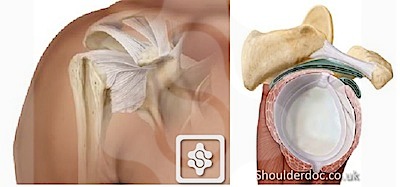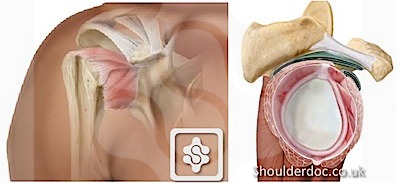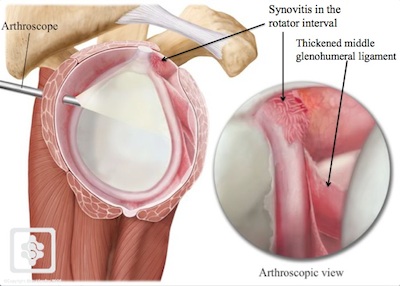Frozen Shoulder
www.shoulderdoc.co.uk
Also known as: adhesive capsulitis
What is it?
Frozen Shoulder is an extremely painful condition in which the shoulder is completely or partially unmovable (stiff). It is one of the most painful conditions of the shoulder (the others being Calcific Tendonitis or referred Nerve pain from the neck).
Frozen shoulder often starts out of the blue, but may be triggered by a mild injury to the shoulder. The condition usually goes through three phases, starting with pain, then stiffness and finally a stage of resolution as the pain eases and most of the movement returns. This process may take a long time, sometimes as long as two or more years.
Frozen shoulder may be associated with diabetes, high cholestrol, heart disease and is also seen in patients with scar tissue in their hands, a condition called Dupuytrens contracture. It may follow an injury to the shoulder or surgery.
The lining of the shoulder joint, known as the 'capsule', is normally a very flexible elastic stucture. It's looseness and elasticity allows the huge range of motion that the shoulder has. With a frozen shoulder this capsule (and its ligaments) becomes inflamed, swollen, red and contracted. The normal elasticity is lost and pain and stiffness set in.
Normal Shoulder Capsule:


Frozen Shoulder Capsule:


Frozen shoulder, as seen at Arthroscopy (note the very swollen and reddened inflamed capsule - it is not surprising that this is such a painful problem!):

Three stages of development:
Typical Primary frozen shoulder develops slowly, and in three phases:
Treatment
If nothing is done most frozen shoulders improve significantly over 2-4 years after onset. However the pain and limitations of the stiff shoulder generally require treatment. The treatment required depends on the severity of the pain and stiffness. These include:
- Physiotherapy - to prevent any further stiffness and regain range of motion
- Painkillers and anti-inflammatories
- Injections - reduce inflammation and provide pain relief
- Hydrodilatation Procedure - more effective than simple injections in relieving severe pain and imrpoving range of motion
- Surgery - Surgery has been shown to be of benefit in both the early and later stages of a Frozen Shoulder. This may involve an arthroscopic Capsular Release or Manipulation Under Anaesthetic (MUA). We prefer the Capsular Release procedure. It is excellent for both pain relief and restoring movement, with a success rate of 96% at 6 months. Intensive physiotherapy is essential after the surgery.

Sem comentários:
Enviar um comentário
Gostou do meu Blog? Envie a sua opinião para lmbgouveia@gmail.com